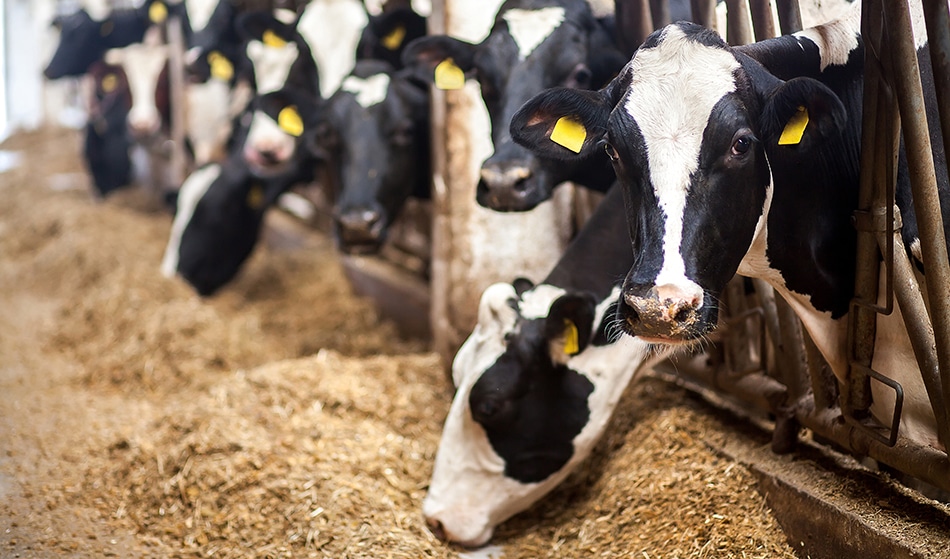Contamination of Animal Feeds Affects Livestock Production-Research in Kenya reveals
 By David Chebutia Kemboi 1,2,† , Phillis E. Ochieng 3,4,†, Gunther Antonissen 3,5 ,Siska Croubels 3 , Marie-Louise Scippo 4, Sheila Okoth 6 , Erastus K. Kangethe 7,
By David Chebutia Kemboi 1,2,† , Phillis E. Ochieng 3,4,†, Gunther Antonissen 3,5 ,Siska Croubels 3 , Marie-Louise Scippo 4, Sheila Okoth 6 , Erastus K. Kangethe 7,
![]() Johannes Faas 8 , Barbara Doupovec 8, Johanna F. Lindahl 9,10,11,* and James K. Gathumbi 1,*
Johannes Faas 8 , Barbara Doupovec 8, Johanna F. Lindahl 9,10,11,* and James K. Gathumbi 1,*
Mycotoxins are secondary metabolites produced by fungi and pose a serious problem to human and animal health when consumed in food and feed. These metabolites are produced by molds of different genera, in particular Aspergillus, Fusarium, and Penicillium, but also Alternaria and Claviceps. In the livestock sector, mycotoxins cause reduced feed intake and feed utilization, suppression of immunity, alter reproduction as well as causing hepatotoxicity, nephrotoxicity, mortality, and subsequently serious economic losses.
The animal health effects vary from one animal species to the other, the type of mycotoxins, duration, and levels of exposure. In addition, some mycotoxins are passed into animal products such as milk, meat, and eggs and thus pose a food safety concern to humans. In Kenya high levels of mycotoxins, especially aflatoxins (AFs) have been reported in feeds. Overall, AFs are the most commonly tested and detected mycotoxins in Africa because of their high toxicity and prevalence in feed and feed ingredients. They are also the most regulated in feeds and food in many countries . In Kenya, apart from AFs, deoxynivalenol (DON), fumonisins (FUM, expressed as the sum of fumonisin B1 (FB1) and fumonisin B2 (FB2)), ochratoxin A (OTA), and zearalenone (ZEN) have also been reported in animal feeds.
Regulatory limits have been set for AFs in animal feed and milk in Kenya, but not for other mycotoxins, hence there is little monitoring done for the other mycotoxins in animal feeds. This lack of regulation is also present in most sub-Saharan countries with the regulations only addressing AFs, except for South Africa where guidance levels exist for ZEN, FUM, and DON in animal feeds . Worldwide, the World Health Organization/Food and Agriculture Organization of the United Nations (WHO/FAO) through the Codex Alimentarius Commission (CODEX) have set up a regulatory limit for AFB1 in animal feeds which most African countries have adopted while the European Union (EU) and the United States of America through the United States Food and Drug Agency (USFDA) have also established a regulatory limit for AFs and guidance limits for other mycotoxins . And despite their regulation being stricter, the EU is a major destination of trade for most African countries, and hence the EU regulatory and guidance values are used for comparison since they may negatively impact trade and in addition they cover a wide variety of feeds for different species.
Little has been done to detect other unregulated fungal metabolites, plant toxins, and bacterial metabolites in feeds and feed ingredients in Kenya, however, they do occur in feeds with either adverse, beneficial, or unknown effects on animal health [16–21]. Ergot alkaloids are produced by fungi from the genus Claviceps and frequently contaminate cereals. Consumption of ergot alkaloids in feed has a negative impact on the feed intake, animal growth, and reproduction, hence affecting animal performance [19]. Other unregulated metabolites from Aspergillus, Fusarium, and Penicillium fungi have also been reported to contaminate feed with studies showing some as emerging mycotoxins having a negative impact on animal health and performance [18,20], and with some having additive effects on other regulated mycotoxins [18]. Alternaria mycotoxins are a group of toxins produced by fungi from the genus Alternaria that affect plants such as cereals and oilseeds. There are more than 70 Alternaria toxins that belong to the chemical groups such as nitrogen-containing compounds, steroids, terpenoids, pyranones, quinines, and phenolics with alternariol (AOH), alternariol monomethyl ether (AME), tenuazonic acid (TEA), and tentoxin (TEN) being the major and most studied and having toxicological concern [18,20]. Despite little being known on the toxicological mechanism of most
Alternaria toxins, they are hazardous to animal health through cytotoxicity, genotoxicity, fetotoxicity,and teratogenicity [16].
Bacterial metabolites are byproducts from bacteria that contaminate feed and while they may be considered beneficial since some are antibiotics, they may also lead to increased development of antibiotic-resistant bacteria [20].
Apart from fungal and bacterial metabolites, some plant compounds found in the feed may also have adverse effects on the animal. Phytoestrogens are non-steroidal phenolic plant compounds with a similar structure to estradiol and hence bind with estrogen receptors and may inhibit or promote estrogenic response. Soybean is the major source of these phytoestrogens with dietary phytoestrogens having adverse effects on animals [21–23].
Co-occurrence of different mycotoxins can cause synergistic, additive, or antagonistic effects, with for example FUM reported to increase the uptake of AFs and subsequently the carry-over to milk [24].Therefore, there is a need to regularly monitor the levels of multiple mycotoxins as well as other bacterial metabolites and plant compounds in animal feeds, to have adequate information for effective mycotoxin management and to safeguard animal and human health.
The objective of this study was therefore to assess the natural co-occurrence and levels of fungal metabolites, bacterial metabolites, and plant toxins in dairy cattle, poultry feeds, and feed ingredients used for animal feed in Kenya.
Results
A total of 153 toxins, comprising mycotoxins, plant, and bacterial toxins, were detected in the samples. All the samples were co-contaminated with between 21 to 116 different mycotoxins and/or fungal metabolites (Figure 1). Further details of the co-occurrence can be found in
Bacterial metabolites are byproducts from bacteria that contaminate feed and while they may be considered beneficial since some are antibiotics, they may also lead to increased development of antibiotic-resistant bacteria [20].
Apart from fungal and bacterial metabolites, some plant compounds found in the feed may also have adverse effects on the animal. Phytoestrogens are non-steroidal phenolic plant compounds with a similar structure to estradiol and hence bind with estrogen receptors and may inhibit or promote estrogenic response. Soybean is the major source of these phytoestrogens with dietary phytoestrogens having adverse effects on animals [21–23].
Co-occurrence of different mycotoxins can cause synergistic, additive, or antagonistic effects,with for example FUM reported to increase the uptake of AFs and subsequently the carry-over to milk [24]. Therefore, there is a need to regularly monitor the levels of multiple mycotoxins as well as other bacterial metabolites and plant compounds in animal feeds, to have adequate information for effective mycotoxin management and to safeguard animal and human health.
The objective of this study was therefore to assess the natural co-occurrence and levels of fungal metabolites, bacterial metabolites, and plant toxins in dairy cattle, poultry feeds, and feed ingredients used for animal feed in Kenya.
